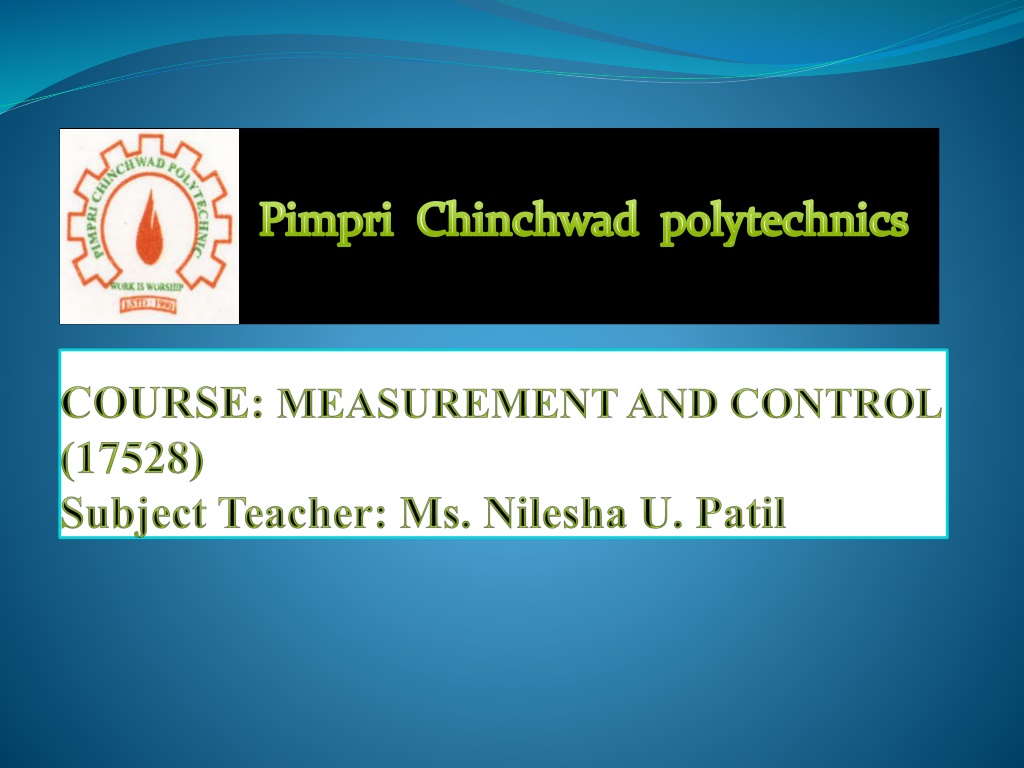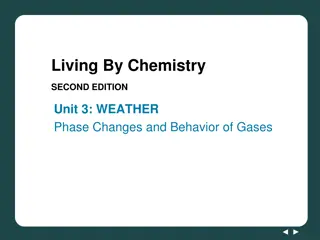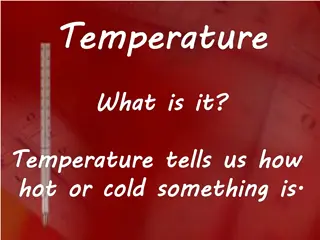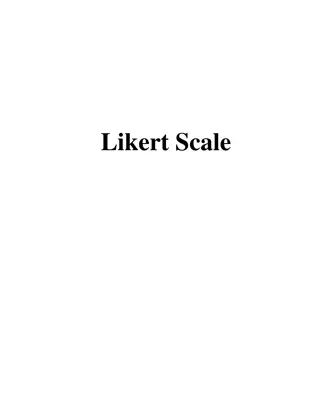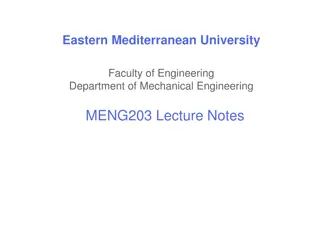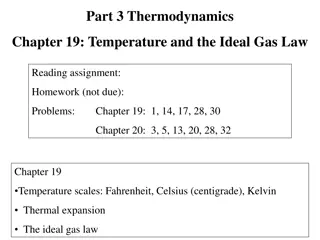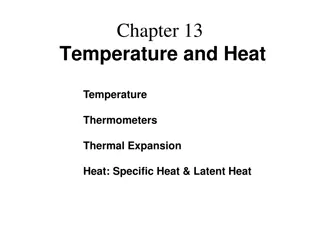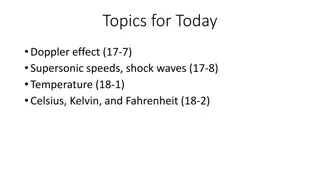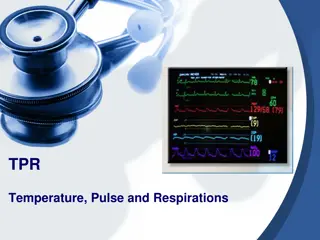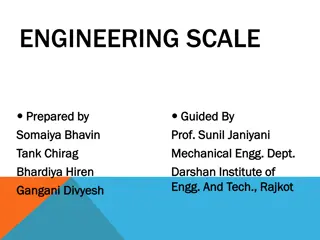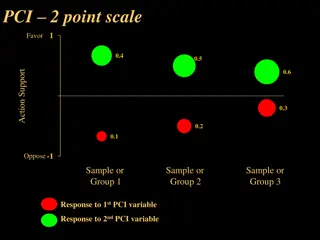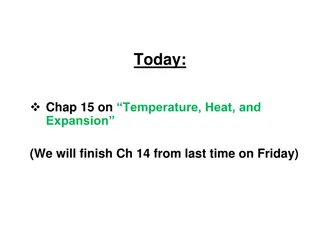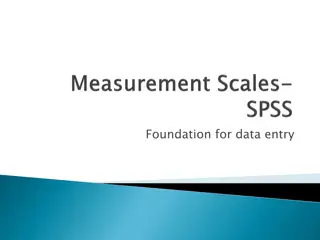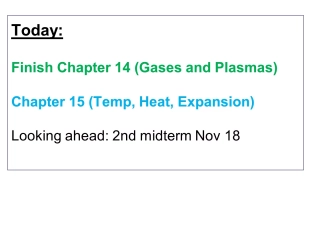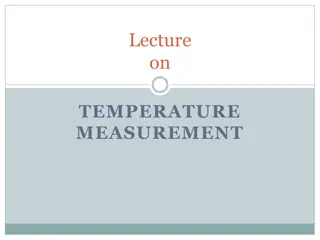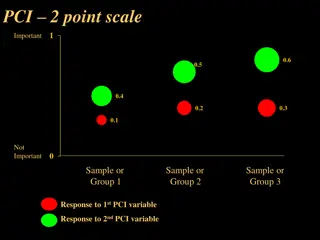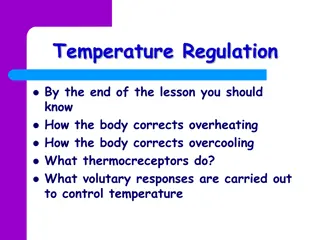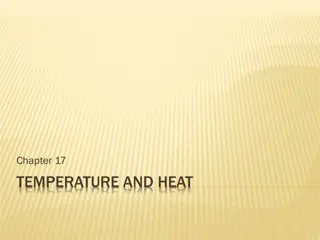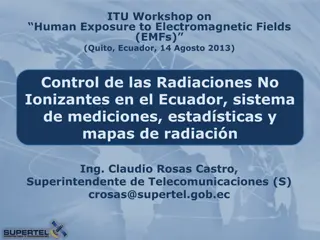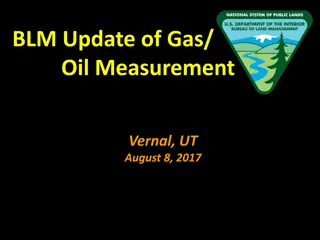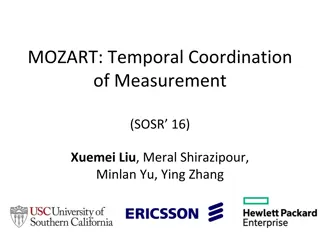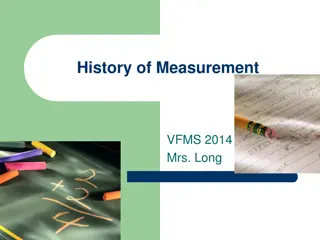Understanding Temperature Measurement and Scales
Temperature measurement involves assessing the hotness or coldness of a body, with various scales like Fahrenheit, Celsius, Rankine, and Kelvin used as reference points. Different temperature measuring devices are classified based on the nature of the change they produce, including glass thermometers, pressure gauge thermometers, bimetallic thermometers, electrical resistance thermometers, thermocouples, optical pyrometers, radiation pyrometers, and fusion pyrometers.
Download Presentation

Please find below an Image/Link to download the presentation.
The content on the website is provided AS IS for your information and personal use only. It may not be sold, licensed, or shared on other websites without obtaining consent from the author. Download presentation by click this link. If you encounter any issues during the download, it is possible that the publisher has removed the file from their server.
E N D
Presentation Transcript
Co-Know the different temperature measuring instrument with their construction and working
Temperature measurement Temperature is measure of thermal energy in a body. It is the hotness or coldness of a medium Hotness or coldness is indication of heat and is compared by giving some reference of unit
Temperature scale A) Fahrenheit scale: Abbreviated as ( F) First to gain acceptance Proposed in the early 1700s by Fahrenheit (Dutch) Freezing point- 32 C, Boiling point- 212 C 1) 2) 3) 4)
. B) Centigrade or Celsius scale: Abbreviated as ( C) Proposed in the mid 1700s by Celsius (Sweden) Freezing point- 0 C, Boiling point- 100 C 1) 2) 3)
. C) Rankine scale: Abbreviated as ( R) Proposed in the mid 1800s by Rankine Freezing point- 491.6 C, Boiling point- 671 C Based on Fahrenheit scale 1) 2) 3) 4)
. C) Kelvin scale: Abbreviated as ( K) Proposed in the late 1800s by Lord Kelvin Freezing point- 273.15 C, Boiling point- 373.15 C Based on Celsius scale 1) 2) 3) 4)
Classification of Temperature Measuring Devices Based on nature of change produced: i) Glass thermometer:- Work on the principle of expansion of liquid like mercury, alcohol, pentane etc. ii) Pressure guage thermometer:- produce pressure O/P on a/c of vapour or liquid. a) liquid filled b) vapour filled c) gas filled iii) Bimetallic thermometer or differential thermometer:- O/P is on a/c of differential expansion of dissimilar metals produced by temp.
. iv) Electrical resistance thermometer:- temperature is measured by resistance o electrical wire v) Thermocouples:- Temperature is indicated by production of emf vi) Optical pyrometer:- Temperature is determined by luminosity of hot body that of a calibrated source vii) Radiation Pyrometer:- Measures temp by absorbing radiation viii) Fusion pyrometer :- Temp. is determined by which of a series of material with graduated fusion material melt or soften due to temp.
. ix) Calorimetric pyrometer:- Temp. is determined by measuring quantity of heat removed when temp. of body brought from unknown to known level. x) Electrical and non electrical type:- Those which are electrical or electronic in nature and those which are not. xi) Temperature range:- Range for which different types of temp measuring devices are used along with their accuracies. xii) Thermister:- It measures temp by relating change in resistance with change in temp
Non electrical methods 1) Expansion thermometer a) Expansion of solid 1) Bimetallic thermometer b) Expansion of liquid 1) Liquid in gas thermometer 2) Liquid in metal thermometer c) Expansion of gas 2) Filled system thermometer 1) Gas filled thermometer 2) Liquid filled thermometer 3) Mercury filled thermometer 4) Vapour filled thermometer 3) Pyrometer
LIQUID IN GLASS THERMOMETER Construction The unit consists of glass envelope, a responsive liquid and an indicating scale The envelope comprises a thick walled glass tube with capillary bore and cylindrical bulb filled with liquid Size of capillary depends on the sensing bulb, responsive liquid and desired temp range.
.... Working Changes in temp will cause the fluid to expand and rise up the stem Since the area of stem is much less than bulb, relatively small changes of fluid volume will result in significant fluid will rise in the stem Length of the movement of free surface of fluid column serves, by prior calibration to indicate temp of bulb
Advantages Simple to use Low cost Easily portable Ease of checking for physical damage No need of auxiliary power No need of additional indicating instruments Good accuracy
Disadvantages Fragile construction Can not be adopted for remote reading Time lag Limited range (about 600 C)
Bimetallic thermometer Construction A metallic thermometer consists of two pieces of different pieces of different metals having different coefficient expansion firmly bonded together by welding Bimetallic elements can be arranged in the flat, spiral, single helix configuration One end of helix is anchored permanently to the casing and the other end is secured to the pointer
Working In response to temperature change, the bimetal expands and the helical bimetal rotates at its free end When free end of bimetallic strip is heated ,it bends in the direction of material having low thermal coefficient of expansion This movement is connected to pointer which moves over calibrated scale The curvature of bimetal spiral strip varies with temp and causes a pointer to deflect
Advantages Low cost Simple in design Compact and robust in construction No maintenance is required Overloading can be tolerated
Disadvantages Low speed of response Creep at high temperature
Pressure Thermometer A pressure thermometer operates by expansion of gas or liquid. A pressure thermometer measures temperature indirectly by measuring pressure. The gauge is a pressure gauge, but is typically calibrated in units of temperature instead.
Pressure Thermometer Construction A thermal system partially filled with a volatile liquid and operating on vapour pressure that depends on temperature at the free surface of liquid. The bulb is partially filled with a volatile liquid and rest of system contains vapour
Types of Pressure Thermometer Liquid pressure thermometers. Vapour pressure thermometers. a. b. Pressure Gauge Thermometer. 25
LIQUID PRESSURE THERMOMETER It is temperature measuring device whose operation is based on thermal expansion of a liquid. These are also called as fluid-expansion thermometers. Liquid filled thermometers have range from -30 C to 250 C. The measurement accuracy depends on the depth of immersion of the thermometer in the medium to be measured.
. Working An increase in the temp. at the bulb causes vapourization of volatile liquid The resulting increase in vapour pressure is measured by a pressure spring and instrument is calibrated in terms of temp. For cross ambient temp. measurement ,dual fill system is used. In this two different liquids vapourizing and non vapourizing are used
LIQUID PRESSURE THERMOMETER Pressure Gauge Thermometer. 28
Construction and Working : A bulb containing a liquid is immersed in the environment. The bulb is connected by means of capillary tube to a pressure measuring device, like a bourdon tube pressure gauge. An increase in temperature causes the liquid to expand, which causes increase in pressure on gauge. The liquid filled tube are also temperature sensitive so it may cause error. Error can be reduced by increasing bulb size, but it may increase the response time of system. The system with bulb, tube, and a pressure gauge can be calibrated directly. Pressure Gauge Thermometer. 29
VAPOUR PRESSURE THERMOMETER These are similar to liquid filled thermometers, but contain only partially filled bulbs. Vapour pressure thermometer have range of 20 C to 350 C. The saturated vapour pressure of volatile liquid is used as a measure of temperature. Pressure Gauge Thermometer. 30
Construction and Working: They use the principle that the vapour pressure of a liquid depends on the temperature, and most fluids partially filled in an enclosed chamber will create a definite vapour pressure. When the fluid reach the boiling point, the vapour pressure will be equal to the total pressure above the liquid surface and can be used as the measure of temperature. Further when the partially filled bulb senses the temperature vapour will be formed in the remaining space of the bulb and is passed through a capillary tube to the indicator with a bourdon tube. Pressure Gauge Thermometer. 32
Advantages Simple and inexpensive Rugged construction Ease of installation and use Fairly good response, accuracy and sensitive Self operated system Remote indication (upto 100 m)
Disadvantages Large time lag Compensation required for ambient temp. Upper limit for measurement is low as compared to electrical system
Range: Liquid Range ( C) Argon down to -253 C Ethyl 90-170 Methyl chloride 0-50 Water 120-220
Applications : Dairy and Food Industries. Suitable for Heating and Ventilation application. Pressure Gauge Thermometer. 36
Electrical Methods: resistance thermometer Can be called as Resistance temperature detector Resistance-Temperature relationship R= Ro(1+ ) here, -temp coeff. Of resistance -Temp. relative to 0 C If change in temp. from 1 & 2 is considered R1= Ro(1+ 1) R2= Ro(1+ 2) Rearrangement gives: 2= 1+(R2-R1/ R0) R2-R1/ 2- 1= R0 Thus change in resistance is directly proportional to change in temp.
RTD RTD can also be called a resistance thermometer as the temperature measurement will be a measure of the output resistance. The main principle of operation of an RTD is that when the temperature of an object increases or decreases, the resistance also increases or decreases proportionally. ie. positive temperature coefficient
Construction : It comprises a bulb or resistance element ,suitable electrical leads and an indicating-recording instrument Bulb is in the form of coil of very fine platinum, nickel wound onto an insulating ceramic former Ceramic former is protected by metal sheath Industrial resistance thermometer, often referred to as RTD are usually made with elements of platinum, nickel and copper
. Working: Change in temp will cause change in resistance of the coil Leads are taken out of the thermometer for the measurement of changes in resistance Range: Upto 1200 C
Advantages: Simplicity in operation Easy installation Replacement of sensitive bulb Average temp can be measured Very high accuracy Excellent stability and reproducibility Ability to be matched to close tolerances for temperature difference measurements. Ability to measure narrow spans Suitability for remote measurement
Disadvantages: More time lag due to protective sheath Possibility of current leakage Susceptibility to mechanical damage Need for lead wire resistance compensation Sometimes expensive Susceptibility to self-heating error Susceptibility to signal noise Unsuitability for bare use in electrically conducting substance Generally not repairable Need for power supply
Thermistor Principle: Thermistors are semiconductor having negative temp coeff. As temp increases, resistance goes down and as the temp decreases ,resistance goes up Temp-resistance relationship is given by- Rt= RoB(1/T-t/To)
. Construction Thermistors are composed of mixture of metallic oxides such as manganese, nickel, cobalt, copper, iron and uranium These metallic oxides are mixed in appropriate properties and are pressed into desired shape with appropriate binders and finally sintered Thermistors may be shaped in the forms of beads, disks, washers, rods Glass and metal probes are used for temp measurement
. Working: Temp change will cause change in resistance This change in resistance is measured by using circuitary similar to that of metal conductor Range Approximately : -100 C to 300 C
. Advantages : High sensitivity Availability in very small size Fast thermal response Low cost
Thermoelectric measurement Thermocouple Radiation pyrometer Optical pyrometer
-Pyro is a greak word which means fire. -Pyrometer is a non contact type instrument Which is used to measure temperature.
Pyrometer Optical system & detector Optical system- Thermal radiation detector Output thermal radiation Temperature is sensed
